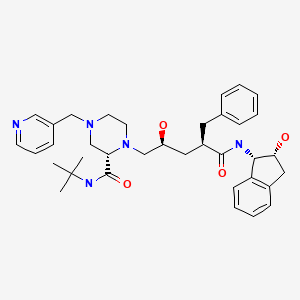Attribution Statement: LactMed is a registered trademark of the U.S. Department of Health and Human Services.
NCBI Bookshelf. A service of the National Library of Medicine, National Institutes of Health.
Drugs and Lactation Database (LactMed®) [Internet]. Bethesda (MD): National Institute of Child Health and Human Development; 2006-.
CASRN: 150378-17-9

Drug Levels and Effects
Summary of Use during Lactation
Indinavir is no longer marketed in the US. Published experience with indinavir during breastfeeding is limited, but some infants may achieve high levels of the drug in breastmilk. Indinavir is not a recommended agent during breastfeeding.[1] Achieving and maintaining viral suppression with antiretroviral therapy decreases breastfeeding transmission risk to less than 1%, but not zero. Individuals with HIV who are on antiretroviral therapy with a sustained undetectable viral load and who choose to breastfeed should be supported in this decision. If a viral load is not suppressed, banked pasteurized donor milk or formula is recommended.[2,3]
Drug Levels
Maternal Levels. One woman was receiving indinavir 600 mg twice daily as part of a highly-active antiretroviral combination regimen. During the first 5 days postpartum milk was collected just before and 2 hours after the dose of indinavir. Milk indinavir concentrations ranged between 90 and 540% of the maternal serum concentration. Further details on the timing, or actual breastmilk concentrations were not provided.[4]
Infant Levels. Relevant published information was not found as of the revision date.
Effects in Breastfed Infants
Relevant published information was not found as of the revision date.
Effects on Lactation and Breastmilk
Gynecomastia has been reported among men receiving highly active antiretroviral therapy. Gynecomastia is unilateral initially, but progresses to bilateral in about half of cases. No alterations in serum prolactin were noted and spontaneous resolution usually occurred within one year, even with continuation of the regimen.[5-7] Some case reports and in vitro studies have suggested that protease inhibitors might cause hyperprolactinemia and galactorrhea in some male patients,[8,9] although this has been disputed.[10] The relevance of these findings to nursing mothers is not known. The prolactin level in a mother with established lactation may not affect her ability to breastfeed.
References
- 1.
- World Health Organization. HIV and infant feeding: Update. 2007. http://whqlibdoc
.who .int/publications/2007 /9789241595964_eng.pdf - 2.
- World Health Organization. Consolidated guidelines on HIV prevention, testing, treatment, service delivery and monitoring: Recommendations for a public health approach. 2021. https://www
.who.int/publications /i/item/9789240031593 [PubMed: 34370423] - 3.
- Department of Health and Human Services. Recommendations for the use of antiretroviral drugs during pregnancy and interventions to reduce perinatal HIV transmission in the United States. 2024. https:
//clinicalinfo .hiv.gov/sites/default /files/guidelines/documents /perinatal-hiv /guidelines-perinatal.pdf - 4.
- Colebunders R, Hodossy B, Burger D, et al. The effect of highly active antiretroviral treatment on viral load and antiretroviral drug levels in breast milk. AIDS 2005;19:1912-5. [PubMed: 16227801]
- 5.
- García-Benayas T, Blanco F, Martin-Carbonero L, et al. Gynecomastia in HIV-infected patients receiving antiretroviral therapy. AIDS Res Hum Retroviruses 2003;19:739-41. [PubMed: 14585204]
- 6.
- Pantanowitz L, Evans D, Gross PD, et al. HIV-related gynecomastia. Breast J 2003;9:131-2. [PubMed: 12603389]
- 7.
- Evans DL, Pantanowitz L, Dezube BJ, et al. Breast enlargement in 13 men who were seropositive for human immunodeficiency virus. Clin Infect Dis 2002;35:1113-9. [PubMed: 12384846]
- 8.
- Hutchinson J, Murphy M, Harries R, et al. Galactorrhoea and hyperprolactinaemia associated with protease-inhibitors. Lancet 2000;356:1003-4. [PubMed: 11041407]
- 9.
- Orlando G, Brunetti L, Vacca M. Ritonavir and saquinavir directly stimulate anterior pituitary prolactin secretion, in vitro. Int J Immunopathol Pharmacol 2002;15:65-8. [PubMed: 12593790]
- 10.
- Montero A, Bottasso OA, Luraghi MR, et al. Galactorrhoea, hyperprolactinaemia, and protease inhibitors. Lancet 2001;357:473-5. [PubMed: 11273087]
Substance Identification
Substance Name
Indinavir
CAS Registry Number
150378-17-9
Drug Class
Breast Feeding
Lactation
Milk, Human
Anti-Infective Agents
Antiviral Agents
Anti-HIV Agents
Anti-Retroviral Agents
HIV Protease Inhibitors
Disclaimer: Information presented in this database is not meant as a substitute for professional judgment. You should consult your healthcare provider for breastfeeding advice related to your particular situation. The U.S. government does not warrant or assume any liability or responsibility for the accuracy or completeness of the information on this Site.
- User and Medical Advice Disclaimer
- Drugs and Lactation Database (LactMed) - Record Format
- LactMed - Database Creation and Peer Review Process
- Fact Sheet. Drugs and Lactation Database (LactMed)
- Drugs and Lactation Database (LactMed) - Glossary
- LactMed Selected References
- Drugs and Lactation Database (LactMed) - About Dietary Supplements
- Breastfeeding Links
- PubChem SubstanceRelated PubChem Substances
- PubMedLinks to PubMed
- Review Nelfinavir.[Drugs and Lactation Database (...]Review Nelfinavir.. Drugs and Lactation Database (LactMed®). 2006
- Review Saquinavir.[Drugs and Lactation Database (...]Review Saquinavir.. Drugs and Lactation Database (LactMed®). 2006
- Review Delavirdine.[Drugs and Lactation Database (...]Review Delavirdine.. Drugs and Lactation Database (LactMed®). 2006
- Review Elvitegravir.[Drugs and Lactation Database (...]Review Elvitegravir.. Drugs and Lactation Database (LactMed®). 2006
- Review Raltegravir.[Drugs and Lactation Database (...]Review Raltegravir.. Drugs and Lactation Database (LactMed®). 2006
- Indinavir - Drugs and Lactation Database (LactMed®)Indinavir - Drugs and Lactation Database (LactMed®)
Your browsing activity is empty.
Activity recording is turned off.
See more...
